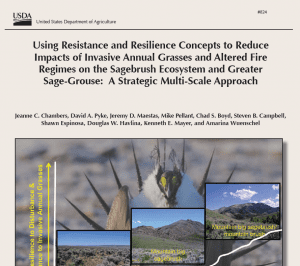Sage-grouse
View paper.
This paper highlights greater sage-grouse egg depredation observations obtained opportunistically from three common raven nests located in Idaho and Nevada where depredated greater sage-grouse eggs were found at or in the immediate vicinity of the nest site, including the caching of eggs in nearby rock crevices. Nests were opportunistically monitored by counting and removing depredated eggs and shell fragments from the nest sites during each visit to determine the extent to which the common raven pairs preyed on greater sage-grouse eggs. These observations may represent the first evidence that breeding, territorial pairs of common ravens cache greater sage-grouse eggs and are capable of depredating multiple greater sage-grouse nests.
View the Order.
This Order sets forth enhanced policies and strategies for preventing and
suppressing rangeland fire and for restoring sagebrush landscapes impacted by fire across the West. These actions are essential for conserving habitat for the greater sage-grouse as well as other
wildlife species and economic activity, such as ranching and recreation, associated with the sagebrush-steppe ecosystem in the Great Basin region.
View report.
This report provides a GIS protocol for identifying strategic locations for fuel breaks to protect remaining large patches of habitat. It was prepared by The Nature Conservancy for the Western Association of Fish and Wildlife Agencies (WAFWA).
Geodatabase that accompanies the report –
File 1 (682MB)
File 2 (84.5MB)
View fact sheet.
This fact sheet from the Sage Grouse Initiative discusses a new soils product that provides the ability to depict potential ecosystem resilience and resistance across the range of sage-grouse using soil temperature and moisture regimes.
View report.
This report provides a strategic approach for conservation of sagebrush ecosystems and greater sage-grouse that focuses specifically on habitat threats caused by invasive annual grasses and altered fire regimes. It uses information on (1) factors that influence sagebrush ecosystem resilience to disturbance and resistance to invasive annual grasses and (2) distribution, relative abundance, and persistence of sage-grouse populations to develop management strategies at both landscape and site scales.
View article.
This study summarizes data from extensive monitoring (2003-12) of sage-grouse populations within the Bi-State DPS. Data regarding lek attendance, movement, and survival of sage-grouse across multiple life stages were documented. A hierarchical integrated population modeling (IPM) approach was used to derive demographic parameters, which allows for the integration of multiple data sources to inform population growth rates and population vital rates.
View report.
This report, developed by the Western Association of Fish and Wildlife Agencies (WAFWA), Wildfire and Invasive Species Initiative Working Group (Working Group), summarizes the current state of Fire Operations and Fuels management functions in big sagebrush communities. The intent of this report is to illustrate the type and responsiveness of efforts being made. Finally, the report concludes by presenting future options and a series of recommendations that may inform future policy and allocation decisions.
View brief.
This brief summarizes a study that provides empirical support for distances between 5 and 7.5 km from leks for surface use designation. It is important to note that sage-grouse space use does not fully inform the extent of no-activity areas. Some industrial activities, such as those generating acoustic pollution, can contribute to negative impacts which extend beyond the physical footprint of each installation.
View article.
This study highlights that forbs are important for survival of sage grouse chicks, but it can be hard to grow enough forbs under sagebrush canopies dense enough to meet recommended cover levels. Selective thinning and targeted cattle grazing may offer a path to a win/win solution.


